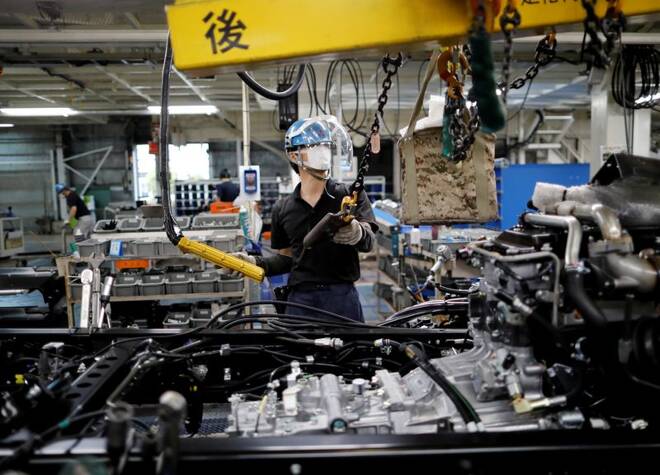Advertisement
Advertisement
Japan firms rising capex fuels hopes for smaller GDP contraction in Q3
By:
By Tetsushi Kajimoto TOKYO (Reuters) - Japanese companies raised spending on plant and equipment in the July-September quarter, Ministry of Finance data showed on Thursday, in a sign business investment remains resilient and a boost to recovery from a COVID-19 induced downturn.
By Tetsushi Kajimoto
TOKYO (Reuters) -Japanese companies raised spending on plant and equipment for a sixth straight quarter in July-September, data released on Thursday showed, though recession risks cloud the outlook for recovery from a COVID-19 induced downturn.
Solid capital expenditure may keep alive hopes for a private demand-led recovery, although overseas economies teetered on the edge of a global slump, led by China whose zero-coronavirus policy curbs have backfired on growth.
The Ministry of Finance (MOF) data showed Japanese firms increased capital spending in the third quarter by 9.8% from a year earlier, extending a trend built on the back of solid demand and a recovery in corporate profits.
The government will use the data to revise gross domestic product (GDP) figures due on Dec. 8.
The rise in firms’ capital expenditure and inventories led some analysts to expect the revision to show the economy’s contraction in the third quarter was not quite as bad as the preliminary estimate released in mid-November.
That early estimate had shown the economy shrank at an annualised clip of 1.2% in the third quarter partly as result of the weak yen, which raised import prices, delivering a blow to consumers and import-reliant businesses.
“I expect the third-quarter GDP to be revised up slightly at annualised contraction of 0.6%. It will rebound this quarter backed by easing of border controls,” said Takeshi Minami, chief economist at Norinchukin Research Institute.
Japan opened its doors to visitors in October after more than two years of COVID isolation, and a domestic travel initiative later that month also raised hopes of a tourism boom.
Minami, however, added a note of caution over the outlook
for the economy.
“You cannot rule out the possibility that the double blow of global recession and cost-push inflation could tip the economy into recession,” he said.
The rising capital expenditure was driven by the need to boost production capacity to meet strong demand at manufacturers for information and communications machinery and chemicals.
The service sector also contributed. Real estate firms’ investment grew 77% year-on-year in the third quarter, and logistics firms also put money into redeveloping facilities like warehouses.
Quarter-on-quarter, seasonally-adjusted capital expenditure rose 2.4%, and was up for the second quarter in a row.
In a sign a weak yen may be helping boost profits at export-reliant big firms, the data showed corporate recurring profits rose 18.3% in July-September, up for a seventh straight month, to reach 19.8 trillion yen ($144 billion), a record amount for a third quarter.
Easing of supply restrictions at carmakers and robust demand for electrical machinery helped boost manufacturers profit growth by 35% in the third quarter, while profits grew 5.6% among non-manufacturers still reeling from fallout from the pandemic.
All firms’ sales rose 8.3% in July-September from a year earlier. Sales have risen for six straight quarters, but this was the fastest gain out of the last five.
($1 = 137.1600 yen)
(Reporting by Tetsushi Kajimoto; Editing by Chang-Ran Kim, Kenneth Maxwell & Simon Cameron-Moore)
About the Author
Reuterscontributor
Reuters, the news and media division of Thomson Reuters, is the world’s largest international multimedia news provider reaching more than one billion people every day. Reuters provides trusted business, financial, national, and international news to professionals via Thomson Reuters desktops, the world's media organizations, and directly to consumers at Reuters.com and via Reuters TV. Learn more about Thomson Reuters products:
Advertisement
